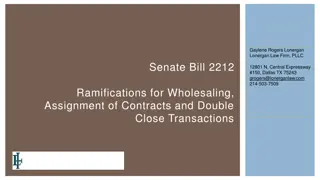Understanding Valuation Methods in Real Estate Investment
Exploring alternative investments in real estate, this content delves into valuation methods like the Discounted Cash Flow (DCF) approach and Term and Reversion approach. It discusses concepts such as discount rates, capitalization rates, and the relationship between them. Furthermore, it demonstrates how to calculate the value of a property using different lease structures, providing a comprehensive overview of real estate valuation techniques.
- Real Estate Investment
- Valuation Methods
- Discounted Cash Flow
- Capitalization Rates
- Alternative Investments
Download Presentation

Please find below an Image/Link to download the presentation.
The content on the website is provided AS IS for your information and personal use only. It may not be sold, licensed, or shared on other websites without obtaining consent from the author. Download presentation by click this link. If you encounter any issues during the download, it is possible that the publisher has removed the file from their server.
E N D
Presentation Transcript
www.gfedu.net Alternative Investments CFA 1-16
www.gfedu.net Private property 2-16
www.gfedu.net Income Approach: DCF Method In discounted cash flow method, the terminal value is NOI R NOI r - g Terminal Value = MV = = n+1 n+1 n 0 Relationship between discount rates and capitalization rates The discount rate (r) : the required rate of return on the real estate investment. The capitalization rate (R0 = r-g): the required rate of return less the expected growth in NOI (increase or decrease in value) 3-16
www.gfedu.net Income Approach: DCF Method Relationship between discount rates and capitalization rates The terminal cap rate is not necessarily the same as the going-in cap rate. Going-in cap rate = PMT / PV The terminal cap rate could be higher if interest rates are expected to increase in the future or if the growth rate is projected to be lower because the property would then be older and might be less competitive. Also, uncertainty about future NOI may result in a higher terminal cap rate. The terminal cap rate could be lower if interest rates are expected to be lower or if rental income growth is projected to be higher. 4-16
www.gfedu.net Valuation with Different Lease Structure In the U.K. the property is said to have reversionary potential when the contract rent expires Method 1: Term and Reversion Approach One way of dialing with the problem is known as the term and reversion approach, whereby the contract (term) rent and the reversion are appraised separately using different cap rates. For example: A single-tenant office building was leased six years ago at 200,000 per year. The next rent review occurs in two years. The estimated rental value (ERV) in two years based on current market conditions is 300,000 per year. The all risks yield (cap rate) for comparable fully let properties is 7%. Because of lower risk, the appropriate rate to discount the term rent is 6%. Estimate the value of the office building. 5-16
www.gfedu.net Term and Reversion Approach Answer: Step 1: Using the financial calculator, the present value of the term rent is: N = 2; I/Y = 6, PMT = 200,000; FV = 0; CPT PV = 366,679 Step 2: The value of reversion to ERV is: ERV 300,000 V = ERV cap rate 7% = = 4,285,714 3 2 Step 3: The present value of the reversion to ERV is: N = 2; I/Y = 7, PMT = 0; FV = 4,285,714; CPT PV = 3,743,309 Step 4: The total value of the office building today is: PV of term rent PV of reversion to ERV Total value 366,679 3,743,309 4,109,988 6-16
www.gfedu.net Valuation with Different Lease Structure Method 2: Layer method A variation of the term and reversion approach is the Layer method, one source (layer) of income is the contract (term) rent that is assumed to continue in perpetuity. The second layer is the increase in rent that occurs when the lease expires and the rent is reviewed. For example: Let's return to the example of the term and reversion valuation approach. Assume the contract (term) rent is discounted at 7%, and the incremental rent is discounted at 8%. 7-16
www.gfedu.net Valuation with Different Lease Structure Answer: Step 1: The value of term rent (bottom layer) into perpetuity is: Term rent Term rent cap rate 200,000 7% = = 2,857,143 Step 2: The value of incremental rent into perpetuity (at time t = 2) is: ( 300,000 200,000 ERV ERV cap rate 8% ) = = 1,250,000 Step 3: Using the financial calculator, the present value of the incremental rent (top layer) into perpetuity is: N = 2; 1/Y = 8 , PMT = 0; FV = 1,250,000; CPT PV = 1,071,674 Step 4: The total value of the office building today is: + = Total value = 2,857,143 1,071,674 3,928,817 8-16
www.gfedu.net Estimates and Assumptions Using the discounted cash flow method requires the following estimates and assumptions, especially for properties with many tenants and complicated lease structures: Project income from existing leases: to track the start and end dates and the various components of each lease Lease renewal assumptions: the probability of renewal Operating expense assumptions: be classified as fixed, variable, or a hybrid of the two Capital expenditure assumptions: expenditures for capital improvements Vacancy assumptions: how long before currently vacant space is leased Estimate resale price: how long the initial investor will hold the property is important Appropriate discount rate: some analysts use buyer surveys as a guide 9-16
www.gfedu.net Allocation of Operating Expenses Example: Allocation of operating expenses Total operating expenses for a multi-tenant office building are 30% fixed and 70% variable. If the 100,000 square foot building was fully occupied, operating expenses would total $6 per square foot. The building is currently 90% occupied. If the total operating expenses are allocated to the occupied space, calculate the operating expense per occupied square foot. Answer: If the building is fully occupied, total operating expenses would be $600,000 (100,000 SF 6 per SF). Fixed and variable operating expenses would be: Fixed $180,000 (600,000 30%) Variable $378,000 (600,000 70% 90%) Total $558,000 So, operating expenses per occupied square foot are $6.20 (558,000 total operating expenses / 90,000 occupied SF). 10-16
www.gfedu.net Compare direct capitalization and DCF methods Compare the direct capitalization and DCF methods Direct DCF capitalization First year NOI Numerator Inputs required Comparable transactions Choosing discount rate Future cash flow Need to forecast what will happened in future. Not doing a detailed lease-by-lease analysis. Less complex Yes No No Yes Common errors made using the DCF method: The discount rate does not adequately capture risk. Income growth exceeds expense growth. The terminal cap rate and the going-in cap rate are not consistent. The terminal cap rate is applied to NOI that is atypical. The cyclicality of real estate markets is ignored. 11-16
www.gfedu.net Question 1 The Imperial office building has annual net operating income of $180,000. A similar office building with net operating income of $300,000 recently sold for $3,000,000. Using the direct capitalization method, the market value of Royal Oaks is closest to: A. $300,000. B. $1,800,000. C. $3,000,000. 12-16
www.gfedu.net Question 1 Solution: B. The cap rate of the comparable transaction is 10% (300,000 N I / 3,000,000 sales price). The value of Royal Oaks is $1,800,000 (180,000 NOI / 10% cap rate). 13-16
www.gfedu.net Question 2 Using the discounted cash flow method, estimate the property value of a building with the following information: NOI for next five years $500,000 NOI in Year 6 $600,000 Holding period 5 years Discount rate 10% Terminal growth rate 4% A. $8,104,607. B. $8,350,729. C. $9,024,472. 14-16
www.gfedu.net Question 2 Solution: A. The terminal value at the end of five years is $10,000,000 [600,000 year 6 payment / (10% discount rate - 4% growth rate)]. The terminal value is discounted to present and added to the present value of the NOI during the holding period. You can combine both steps using the following keystrokes: N = 5; I/Y = 10 PMT = 500,000 FV = 10,000,000 CPT PV= $8,104,607 15-16
www.gfedu.net 16-16























